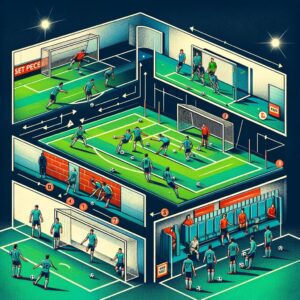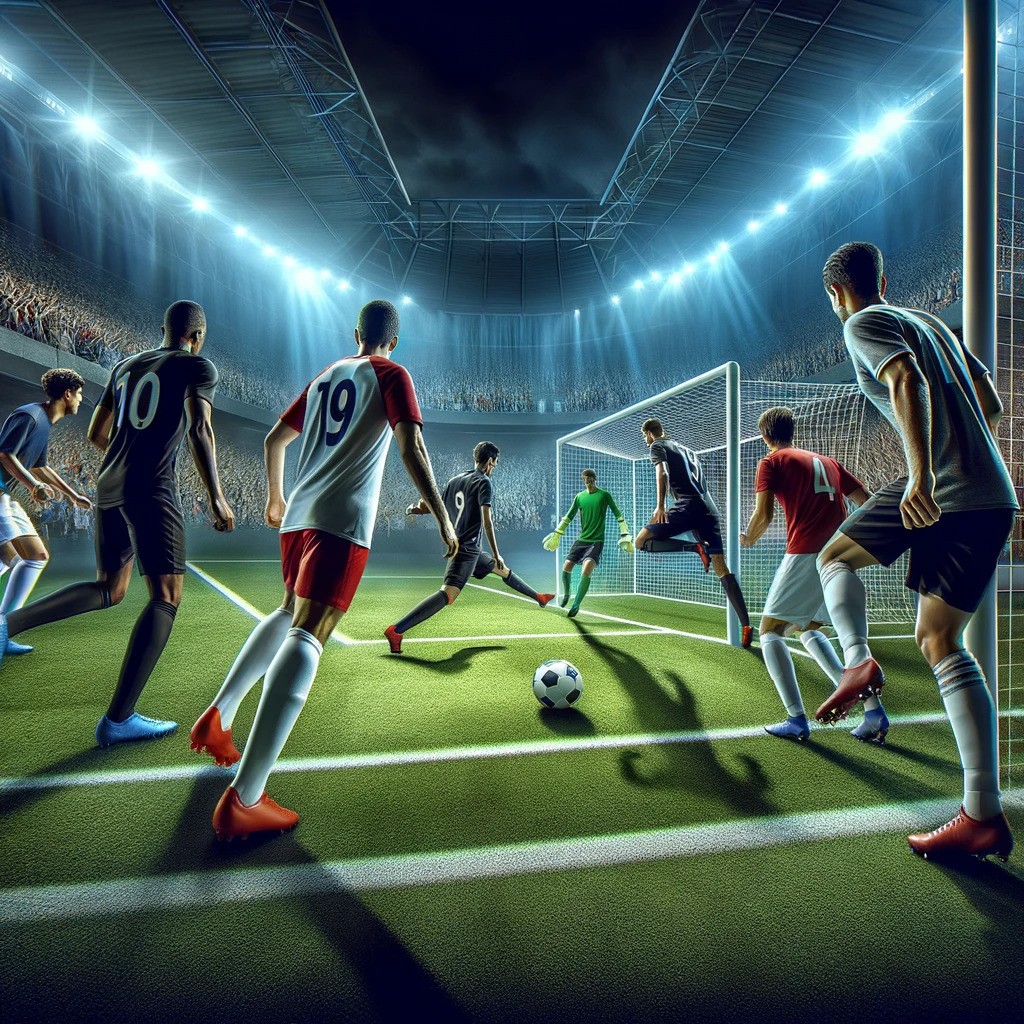Having spent countless hours on the pitch, both playing and coaching, I’ve come to understand the significant role of set pieces in soccer. These moments, often underestimated, can turn the tide of a game. Throw-ins, corner kicks, goal kicks, free kicks, and penalty kicks – each carries its unique tactical weight. In this article, let’s explain these different kinds of set pieces, dissecting their rules and conventions in a way that even those getting started in soccer will find easy to grasp.
Remember how weird and hard to understand the names and laws of soccer seemed when you were new to the game? I certainly do. It was a bit overwhelming at first, but with a simple and straightforward approach, we can demystify these critical aspects. Think of set pieces as chess moves on a soccer field – each with its own number of possible outcomes and strategies.
Whether it’s deciding when to opt for a short or long throw-in, mastering the art of bending a free kick, or choosing the right player for a penalty kick, these moments are pivotal. So, let’s bet on this journey, where worry turns into tactical prowess, and every set piece becomes an opportunity to change the game’s narrative.
What Are Set Pieces in Soccer?
In the world of soccer, set pieces are akin to the strategic pauses in a chess game. These moments are not just breaks in play but pivotal instances that can shift the tide of the match. When a foul is committed or the ball rolls out of bounds, the game is paused. This stoppage is the prelude to a set piece, a term synonymous with opportunity in soccer. From throw-ins to corner kicks, goal kicks, penalties, and free kicks, each set piece represents a tactical battle in itself.
Imagine the scene: the referee’s whistle is blown, signaling a foul or the ball going out of bounds. Players quickly position themselves, aware that the upcoming event, be it a free kick or a penalty, could be the game-changer. In these dead ball situations, the range of possibilities is as vast as the field itself.
Whether it’s a precisely executed corner kick or a strategically placed goal kick, every set piece in soccer is a moment where the ordinary flow of the game occurs in a different, more calculated rhythm. These are the moments where games are won or lost, where the aforementioned events become more than just parts of the game – they become the heart of the soccer narrative.
When Are Set Pieces Used In Soccer?

In soccer, the role of set pieces is pivotal and often game-changing. These scenarios arise when the referee’s whistle is blown following a foul or when the ball rolls out of bounds. In such instances, the usual flow of play comes to a halt, leading to a stoppage. This pause in action is crucial, as it sets the stage for a dead ball situation, the foundation upon which set pieces stand. Whether it’s a corner kick from the flanks, a free kick in a promising position, a tactical goal kick, a decisive penalty, or a well-planned throw-in, each type of set piece offers a unique opportunity to put the ball back into play.
These moments in soccer are not just routine; they are ripe with strategic possibilities. The types of set pieces—corner kicks, free kicks, goal kicks, penalties, and throw-ins—all present different challenges and opportunities. A team skilled in utilizing set pieces effectively can turn these moments of stoppage into powerful offensive weapons or defensive fortifications. In the dynamic world of soccer, understanding and mastering the intricacies of set pieces can often be the difference between victory and defeat.
What Are Throw-ins In Soccer?
In the strategic universe of set piece soccer, the throw-in stands out as a unique element. Unlike other set pieces, a throw-in doesn’t involve kicking the ball. This scenario happens when the ball crosses the touchline or sideline, which are the longest lines on the field. Typically, these lines run along the sides of the pitch. The team that doesn’t touch the ball last before it goes out is awarded the throw-in.
Executing a throw-in requires a specific technique. The player must keep both feet firmly on the ground and bring the ball from behind their back, fully extending it over their head with both hands before throwing it back into play. Interestingly, this is the only time field players—all footballers other than the goalie—are permitted to touch the ball with their hands. This rule adds a tactical layer to the game, as players must skillfully use this opportunity to regain control or advance their position on the field.
What Are Corner Kicks?
In the dynamic world of set piece soccer, the corner kick emerges as a critical play. When the ball crosses the goal line and is last touched by the defending team but doesn’t end in a goal, a corner kick is awarded. The ball is then placed within the marked-off space in the corner of the field on the side it exited. This spot is often at both ends of the field, where the goal line meets the touchline. The corner kick is more than just putting the ball back into play; it’s a strategic opportunity.
During a corner kick, the player kicking the ball aims to latch it onto a teammate, usually within the penalty area or the 18-yard (meter) box, also known as the goal box. Sometimes, the target is even closer, within the 6-yard (meter) goal area. The objective often is a header, a powerful and precise move to direct the ball toward the goal.
Teams often employ set plays, where attacking players position themselves to get open in front of the goal. This is done to increase the chances of knocking the ball into the net. When executed well, a corner kick can turn the tide of a match, especially if the attacking team manages to outmaneuver the defense.
What Are Goal Kicks In Soccer?
In the world of set piece soccer, the goal kick stands as a fundamentally simple yet strategically significant play. The kicker’s purpose during a goal kick is usually to propel the ball as far from their own goal as possible. This play is essential in transitioning from defense to offense, aiming to deliver the ball into the area of the attacking team. The intent is to resume the game and begin an attack with this singular kick.
For the goal kick, the soccer ball is placed on either the right side or the left side of the top of the goal line area, and the choice of side is at the kicker’s discretion. In youth soccer games, the dynamics can be quite different.
Here, it might be simpler for a young player to pass the ball to a defending team member who is close by, especially since children may not have the ability to generate enough power to send the ball down the field. This distinction in play style between youth and professional soccer highlights the evolving nature of tactics in set piece scenarios.
What Are Soccer Penalty Kicks?
Penalty kicks are often considered the easiest type of kicks to understand in soccer, but they also harbor a complexity in their execution and implications. Typically, a penalty kick is called when an attacking player is fouled within the opposing team’s 18-yard box, also known as the penalty area. The referee, exercising their discretion, determines if the foul warrants this significant decision. Unlike simple fouls outside the box, the value and importance of a penalty kick weigh heavily on the referee’s judgment.
The scenarios leading to a penalty kick can vary. A clearly made poor foul by a defender, especially as the last one in a defensive position, or a foul on an attacker during a breakaway, can result in a penalty. Additionally, a handball in the box can also lead to a penalty, though the referee must decide if it was inadvertent or not, as inadvertent handballs are typically not called.
Moving to the penalty spot, situated 12 yards (or meters) from the center of the goal, sets the stage for a dramatic one-on-one situation between the penalty taker and the goalie. Here, no dribbling is allowed. The kicker must approach the ball in a fluid motion, while the goalie is restricted to the goal line and cannot leave it before the ball is kicked.
As for the other players in the game, they must stay outside the penalty area until the ball is kicked. This rule ensures that the focus remains solely on the kicker and the goalkeeper. Once the ball is kicked, however, players can charge in, often leading to intense follow-up plays or rebounds.
This set piece play is not just a test of skill but also a psychological battle. The goalie and the penalty taker each try to outwit the other in these high-pressure moments. The kicker must maintain composure and precision, while the goalkeeper must anticipate and react swiftly.
What Are Free Kicks?
In the realm of set piece soccer, free kicks offer a wide variance of situations and strategies. They are divided into two types: indirect kicks and direct kicks. Indirect kicks usually result from offsides or less serious fouls like unsporting behavior. In contrast, direct kicks are more common, often awarded for a contact foul or handball. For an indirect kick to count as a goal, it must be touched by at least one more player before being put on the net, whereas a direct kick can be shot directly at the goal.
When free kicks occur at the defensive end of a team, they are similar to goal kicks. The purpose here is to advance the ball up the field with the help of teammates. Simply booting the ball into a crowd of players often leads to a loss of possession. In this scenario, coordination and precision are key to retaining control and transitioning to an offensive play.
Conversely, free kicks at the attacking end of the field present a direct opportunity to create an open look on goal. The closer the kick is to the goal, the easier it is to score. In these moments, the attacking team’s strategy is centered around maneuvering into a position where they can effectively challenge the opposing goalkeeper, turning a free kick into a pivotal scoring opportunity.
Common Set Piece Mistakes
In the world of soccer, mastering set pieces is crucial for a team’s success. However, common mistakes can often prevent a team from scoring. One of the biggest pitfalls is the lack of communication among players. This shortfall can lead to uncertainty about their roles and the intended target of the set piece. Such confusion often results in missed opportunities. It’s common to see players who don’t know their exact role, or rely too heavily on personnel they practiced with, only to find a different group in actual games. Clear communication between the coach and players during the setup is essential.
Poor timing is another significant issue. If players are not in the right position at the right time, the execution of the set piece may not be successful, leading to frustration within the team. To combat this, practice of set pieces during training sessions is vital. Players must understand the timing of the set piece and synchronize their runs with the delivery of the ball. Teams should practice regularly and adjust their movements based on the timing of the delivery.
The third common mistake is inaccurate delivery or lack of execution. If the set piece’s delivery is not precise, it becomes challenging for players to make contact with the ball and score. This can lead to a domino effect where the planned strategy crumbles. It’s crucial to ensure that the player delivering the ball has both good technique and accuracy.
Conclusion
In the intricate tapestry of set piece soccer, every corner kick, free kick, penalty, or throw-in holds the potential to alter the course of a game. Mastering these set pieces is not just about perfecting techniques; it’s about cultivating communication, timing, and precision within a team.
As we’ve explored, avoiding common mistakes and harnessing the power of these critical moments can transform a soccer team from merely competent to truly formidable. The beauty of soccer lies in these details, where strategy, skill, and teamwork converge to create moments of magic on the field. For teams aspiring to greatness, a well-executed set piece can be the key to unlocking victories and achieving soccer excellence.
Frequently Asked Questions
What is a set piece in soccer?
A set piece in soccer refers to any play that restarts the game after a stoppage, typically following a foul or the ball going out of bounds. These are pre-planned strategies used to gain a tactical advantage.
How many set pieces are there in football?
In football (soccer), there are several types of set pieces, including corner kicks, free kicks, penalty kicks, throw-ins, and goal kicks. Each serves a different purpose and occurs under specific game circumstances.
What is the difference between open play and set piece?
Open play in soccer refers to any phase of the game where the ball is in play and the game flows continuously. In contrast, a set piece occurs after a stoppage and is a structured play, like a free kick or corner kick.
What is meant by a set piece?
A set piece in soccer is a term used to describe a situation in a game where the ball is set back into play following a stoppage, often involving strategic planning and execution. These plays are crucial for scoring opportunities.
Is a goal kick a set piece?
Yes, a goal kick is considered a set piece in soccer. It is awarded to the defending team when the ball crosses their goal line without a goal being scored and last touched by the attacking team.
How many goals come from set pieces?
The exact number of goals from set pieces varies across different leagues and tournaments. However, it’s estimated that around 25-30% of goals in professional soccer are scored from set pieces, highlighting their importance in the game.
What makes a good set piece?
A good set piece in soccer is characterized by well-planned execution, precise timing, accurate delivery of the ball, and effective communication among players. Successful set pieces often involve creative strategies to outmaneuver the opposing team’s defense.

